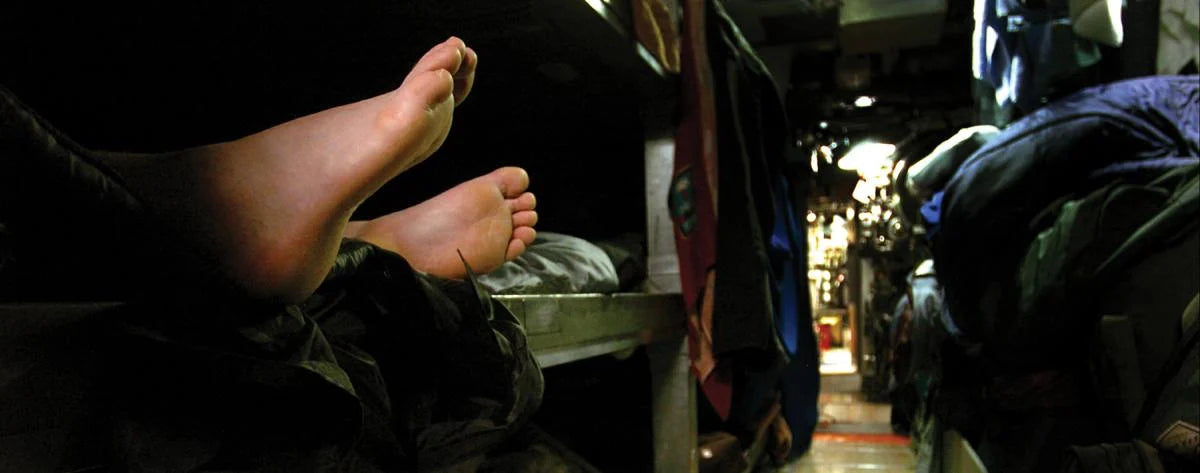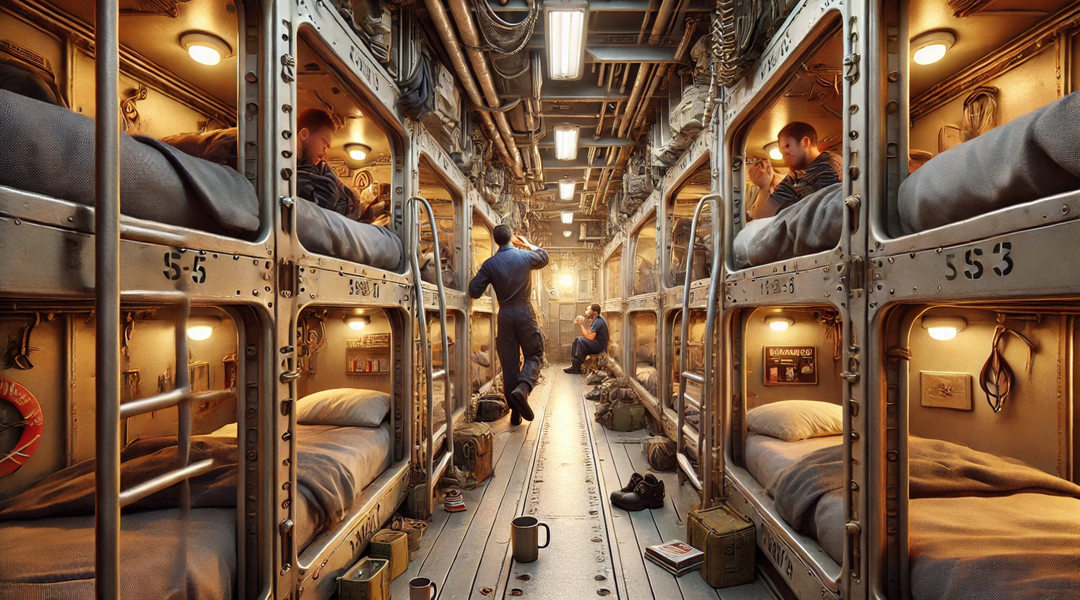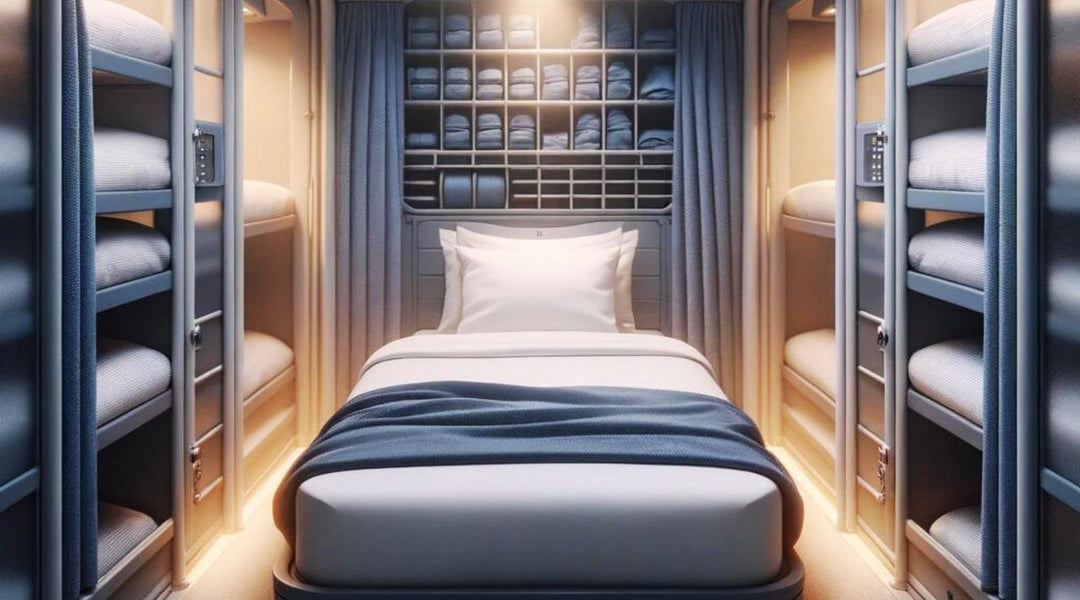Critical Rest: The Strategic Role of Sleep in Naval Operations

Imagine navigating a ship through treacherous waters after 36 hours without sleep. For sailors, sleep isn't a luxury; it's as crucial as their survival gear. Quality sleep is especially important on naval ships, where sailors are charged with completing complicated missions in challenging and frequently high-stress conditions. Adequate sleep on military ships is important for more than just the individual mental health of crew members; it has a direct impact on tactical preparedness, safety, and the general efficiency of naval forces.
On a naval ship, optimizing sleep transcends personal health; it's a strategic imperative critical to mission success. This post explores the paramount importance of sleep on navy ships, delving into its multifaceted impact on both sailors and the mission they are entrusted with.
The Naval Environment and Its Sleep Challenges
Irregular work schedules pose a major sleep challenge in the naval environment. Sailors often stand night watches or work extended hours, disrupting normal sleep patterns and leading to health and psychological issues. During operations, sailors may be expected to stand watch at night or work extended hours, resulting in irregular sleep habits. This frequent disturbance of sleep patterns,or deprivation of sleep may lead to several health and psychological issues.
Recently, the Navy has introduced wearable devices that monitor sleep patterns and apps that provide feedback, helping sailors maximize their rest and maintain their readiness. Wearable devices and apps can track sleep patterns and provide feedback to sailors, helping them understand their sleep quality and identify areas for improvement. Additionally, sleep education programs and workshops can teach sailors relaxation techniques and stress management strategies to help them cope with the unique challenges of naval service.
Adopting more flexible watch-standing schedules can align with sailors' natural circadian rhythms, reducing sleep disruptions and enhancing overall alertness. Some naval units have experimented with alternative watch rotations that aim to align with sailors' natural circadian rhythms. While this strategy may not be appropriate for all operations, it can assist prevent sleep interruption and enhance overall sleep quality.
Furthermore, the military community has acknowledged the need of providing sailors with chances for leisure and relaxation while on deployment. Creating dedicated "quiet hours" or "protected sleep time" might help sailors obtain the rest they need, even while engaged in intensive missions.
The Navy Rack and How To Make It Comfortable For Sleep
Sailors aboard naval vessels routinely face unique challenges and sacrifices, particularly when it comes to finding comfort in the cramped space of a Navy rack. One such challenge is finding comfort in the confined space of a Navy rack, where they must sleep, work, and spend significant portions of their lives during deployments. The Navy rack, a compact sleeping compartment, may not offer the luxuries of a spacious bedroom, but with a few creative tips and tricks, sailors can transform these tight quarters into a relatively comfortable sleeping space.
The typical Navy rack is designed for efficiency and space-saving, prioritizing functionality over comfort. It consists of a narrow, metal-framed bunk with a thin mattress and minimal personal storage space. However, here are some ways to improve the quality of sleep for sailors who spend months at sea.
1. Mattress Topper: Adding a quality mattress topper is one of the simplest, yet most effective, upgrades to transform a stark Navy rack into a more comfortable sleeping space. A topper made of memory foam or gel can give much-needed padding and support. It will not only increase the mattress comfort, but it will also assist minimize pressure spots and improve the quality of your sleep.
2. Bedding: Investing in top grade bedding may make a considerable difference in a Navy rack's comfort and satisfaction. Soft, breathable sheets and a cozy blanket can help create a more inviting sleeping environment. Additionally, consider bringing a favorite pillow from home to provide additional comfort and familiarity.
3. Blackout Curtains: Naval vessels operate around the clock, meaning sailors may need to sleep during daylight hours. Installing blackout curtains and liners around the rack can help block out the sunlight, making it easier to rest. Darkness can also promote better sleep by signaling to the body that it's time to rest.
4. Earplugs and Eye Mask: Noise and light can be constant challenges when sleeping in a Navy rack. To combat this, sailors can use earplugs to block out noise from neighboring racks and common areas. An eye mask can help shield their eyes from any ambient light, ensuring a more peaceful sleep.
5. Personal Organization: With limited storage space, organization becomes crucial. Using bins or organizers can help keep personal belongings tidy and easily accessible. By reducing clutter, sailors can create a more comfortable and relaxing space within their rack.
6. Personal Touches: Bringing a touch of home to the Navy rack can boost morale and make the space more comfortable. Personal photos, small decorations, or a favorite book can provide a sense of familiarity and comfort in an otherwise unfamiliar environment.
7. Temperature Control: Navy vessels can experience extreme temperatures, so sailors should be prepared to adjust to both hot and cold conditions. Having a small fan for ventilation or a portable heater for warmth can be essential for creating a comfortable sleep environment.
8. Routine: Establishing a regular sleep routine can help sailors adapt to the unique challenges of sleeping in a Navy rack. Consistency in bedtime and wake-up times, as well as relaxation techniques like deep breathing or meditation, can promote better sleep quality.
9. Premium and Luxury Rack Sheets: A significant portion of a seafarer's life is spent in their bunk or rack. Quality rack sheets can transform this small space into a haven of comfort. Premium rack sheets are often made from high-quality materials like Egyptian cotton or microfiber, ensuring softness and durability. These sheets are designed to withstand the rigors of life at sea, providing a cozy retreat after long hours of work.
Moreover, luxury rack sheets can improve sleep quality, which is vital for a seafarer's performance and well-being. Adequate rest is essential for maintaining focus, alertness, and overall health. High-quality sheets help regulate body temperature, wick away moisture, and reduce friction, preventing discomfort and skin irritations that can arise from prolonged contact with low-quality fabrics.
10. Rack Curtain Accessories: Privacy is a precious commodity at sea, especially on vessels with communal living arrangements. Rack curtain accessories can offer a sense of personal space and privacy, enhancing the quality of life for seafarers. These curtains can be easily installed around each bunk, creating a private nook for relaxation, reading, or personal reflection.
Rack curtains also serve as a buffer against the constant noise and movement on board, providing a quiet and peaceful retreat. Additionally, they can help manage the limited storage space available in a bunk, allowing seafarers to store personal items discreetly. Rack curtain accessories come in a variety of colors and designs, allowing each crew member to personalize their space, contributing to a sense of ownership and comfort.
11. Deployment Gear: Deployments are a part of life for many seafarers, and having the right gear can make a world of difference. Quality deployment gear ensures the safety and comfort of the crew during challenging missions and operations. Premium life jackets, harnesses, and other safety equipment are essential investments that protect crew members in the most adverse conditions.
In addition to safety gear, deployment equipment such as high-quality waterproof bags, tactical gear, and durable boots can improve the quality of life during missions. Reliable gear not only ensures the safety of the crew but also enhances their effectiveness and confidence while carrying out their duties.
Conclusion
The imperative of ensuring quality sleep aboard naval ships is undeniable. It's not just a matter of health—it's about maintaining operational readiness and safety. Sleep is essential for the physical and mental health of sailors as well as the overall operational preparedness of the ship. It is not only a luxury or a personal pleasure. Maintaining cognitive function, attentiveness, and decision-making abilities—all of which are critical in the high-stress and demanding environment of naval operations—requires getting enough sleep.
Additionally, well-rested sailors who can react quickly to situations and carry out their responsibilities precisely are essential to the crew's safety and the success of missions. Lack of sleep can have a variety of negative effects, such as lowered performance, poor judgment, and a higher chance of accidents.
Recognizing the critical role of sleep in maintaining crew health and operational readiness, the Navy has established specific rules and practices designed to optimize sleeping conditions aboard ships.







Leave a comment